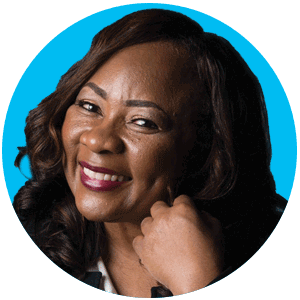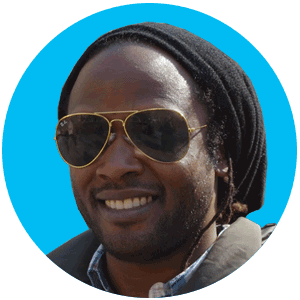Months after George Floyd’s and Breonna Taylor’s murders sparked a wave of national protests against white supremacy, people and organizations across the country are still grappling with what it means to be “antiracist.” Many individuals and organizations have done some hasty messaging to acknowledge the ways in which inequality touches every aspect of society — from public health to policing to climate catastrophes. There have been huge outpourings of support on social media and beyond, including from some pretty unexpected places, for the Black Lives Matter movement.
Now, bolstered by outrage over ongoing police brutality in places like Kenosha, Wisconsin, and Rochester, New York, protesters are more adamant than ever that the time is ripe for change. But, so far, what progress (if any) have we seen? Have the corporations and big green groups that put out Black Lives Matter statements followed through on their messaging?
We spoke to four Grist 50 Fixers who work on issues related to environmental and racial justice about the changes they have witnessed, the work still to come, and how to hold institutions accountable to their promises of an antiracist reckoning. Their responses have been edited for length and clarity.
Building a more perfect union

Catherine Coleman Flowers, founder of the Center for Rural Enterprise and Environmental Justice, and a member of the Biden-Sanders unity task force on climate change
What’s different about this moment is the fact that masses of people around the country are recognizing the interconnectedness of all of these injustices — and the common thread, which is inequality. And I think, this time, there may be a concerted effort to root it out. I am seeing that acknowledgement from places that I didn’t expect. For example, I got something from PetSmart, because I’m a pet owner, and it was a statement about Black Lives Matter. I did not expect that — but it was pleasantly received.
These acknowledgements mean a lot, because people were not acknowledging it before. It’s easy to stick your head in the sand if you believe that there is no problem at all to be addressed. You know, if we look at the 12-step program and how we deal with addiction — the first step is recognizing that you have a problem. So now, the next step is action: with companies and organizations, that means reorganizing internally so that they will no longer facilitate policies and practices that support inequality — whether it’s among women, among people of color, or in regard to the allocation and distribution of resources.
To carry this momentum into policy change, the first thing we’ve got to do, in some cases, is to change the policymakers. One of the most important actions we can take is to encourage everybody to vote. And then the next step is to enact a plan that systematically roots out the policies that are not inclusive, whether it’s at the government level, or within a large corporation or green group.
I’m hopeful, because I think people understand that we cannot afford to be apathetic anymore. I’m seeing more activism on behalf of people in their local communities, and there’s more at stake than ever. I’ve lived through adversity before, and I still believe in the American ideal. That’s the reason we’re out there protesting. And I really think that the protestors and young organizers believe in that ideal, too — more than the people doing all the flag waving, who are actually burning down those institutions that could make America a more perfect union. So that’s where I get my hope, from the people working for change. And I’ll continue to hold out that hope until my last breath to work for that reality to happen.
An old issue, a new hope

Anthony Rogers-Wright, policy coordinator at the Climate Justice Alliance
First and foremost, this is a discussion that frontline communities and environmental-justice leaders and elders have been trying to have for decades. There was an invitation to have this discussion as far back as 1987, when Toxic Waste and Race was released by the United Church of Christ, under the leadership of Dr. Benjamin Chavis — who coined the phrase “environmental racism.” Three years later, there was a letter sent by a coalition of environmental and racial-justice groups to 10 prominent environmental organizations, essentially saying that your organizations are racist. And there were platitudes and apologies, but nothing really changed.
I think that, this time, there are so many things that are elucidating all these interlinked crises that are impacting Black, brown, Indigenous, and poor white people at the same time. We’re facing down a pandemic, which has a proclivity for taking out the same people that the climate crisis takes out first and worst. And then there comes a public lynching — George Floyd, and now other murders at the hands of white police officers over the last few months — that was caught on video for the world to see. These things are so undeniable that the conversation went into overdrive once they came to light.
I salute the mainly white environmental community for the incredible statements of solidarity — and in some cases, the outrage that led white people to pour out into the streets. There’s been a lot of great external work. But, when it comes to the demographics of people who are in decision-making positions, and also the fundraising apparatus, there’s still this massive internal work that needs to be done if we’re going to be effective.
You know how the League of Conservation Voters has their scorecard for lawmakers and candidates? I think we need a scorecard like that for historically white-led environmental organizations — where frontline groups would be the ones who crafted that scorecard and presented it. And hopefully these groups would allow their employees of color to speak candidly, and actually release that assessment. There has to be transparency if there’s going to be righteous accountability.
What’s driving my hope right now is I look out in the streets and I see white people next to Black and brown people, demanding justice. And I think what’s also giving me hope is the manifestation of empathy in place of sympathy. People are going beyond just using activism as a way to up their influencer status, so to speak. People are buying books like White Fragility, or How to Be an Antiracist, or So You Want to Talk About Race, and really doing an analysis of their organizing. That, to me, is almost more important than any policy. We cannot transform society if we don’t transform ourselves.
Shifting culture to shift policy

Thanushka Yakupitiyage, U.S. communications director at 350.org
Some people seem to think that this moment popped out of nowhere — but people don’t just organize randomly out of nowhere. The Movement for Black Lives was ready. Black-led organizations and Black thought leaders have been building the infrastructure for years to make this moment possible. So, certainly, I think this moment is special in the sense that there have been years of organizing that have led to this point.
I think the mainstreaming of the idea of defunding the police — as a tool on the path to police abolition — is huge. The Movement for Black Lives recently introduced a bill called the BREATHE Act. And it was after weeks and months of sort of building the narrative that defunding the police is a key strategy in terms of Black liberation. In order to shift policy, you have to shift culture first. We’ve done that also in the climate movement, by educating people about the depths of the crisis and the impacts of the fossil fuel industry on people and the planet. That narrative had to take hold in the mainstream before we could push forward something like the Green New Deal.
The progress we’ve seen in the Movement for Black Lives recently is amazing. And I do think the messages of support are useful. I remember seeing Uber’s message in my inbox, for example, and just laughing — like, wow, this is really some next-level stuff. Even if you hate Uber, their messaging speaks to the cultural shift on this issue. Still, if companies are just putting out their Black Lives Matter messaging, but their executive boards and leadership teams continue to be white, I don’t care about their Black Lives Matter messaging.
It also has to go deeper than just slotting people of color into positions — that doesn’t mean that a company has a progressive agenda. Part of being an antiracist organization is ensuring that you really understand the connections between all of these issues, and that you’re pushing forward a liberatory agenda.
I think that climate organizations still have a lot to learn around un-siloing their movements, making sure that they’re following the lead of people of color in their movements, and making the climate movement more accessible. And the way to do that is to talk about these issues in an intersectional way.
The pressure is on — and needs to stay on

Elsa Mengistu, youth activist, consultant, and former operations director at Zero Hour
Since the uprisings started this summer, abolition has kind of been on the forefront of everything. In my consulting work, I’ve started having deeper conversations with companies about how white supremacy shapes their internal practices, their leadership makeup, how they make decisions, and that sort of thing. Four months ago, that would have been like, “Oh my God, guys, that’s so radical.” Now it’s a common conversation.
In youth spaces, in the climate space, we’ve really been focusing on environmental racism and justice, and Black liberation through environmentalism. I’ve been having those conversations on panels and round tables, and really just talking to anyone who’ll listen. And there hasn’t been much opposition, or even tension. Pretty much everyone I’ve met so far is on the same page as to what’s going on and what needs to be done.
There has definitely been a push towards recognizing the history of the environmental movement — the racist roots, and the importance now of intersectionality and lifting up Black people and Black trans women. There has been a lot of support for Black organizations and activists who are on the ground. But also, none of us really know if this is something of substance or just a temporary reaction to the protests. Maybe a few months from now, things will go back to the way they were. We really won’t see if these changes are long-lasting or genuine until time passes and we can judge that.
So the pressure is on — and we need to keep it on, even as the country starts to reopen. In Minneapolis, activists’ demand that the city defund the police department in the wake of George Floyd’s death was met in a matter of weeks. But there is still a lot of work to do to hold the system accountable.
I’m helping to found a group called Black Girl Environmentalist, to create a space for Black girls and femmes who are in this movement. People are creating the spaces that they need to thrive; people are cross-pollinating around issues and identities. That’s been really inspiring, and that’s something that makes me hopeful. Now the question is: How do we maintain it and add to it down the road?
PrintClaire Elise Thompson | Radio Free (2020-09-17T07:56:18+00:00) What’s next for climate and racial justice? Four experts weigh in.. Retrieved from https://www.radiofree.org/2020/09/17/whats-next-for-climate-and-racial-justice-four-experts-weigh-in/
Please log in to upload a file.
There are no updates yet.
Click the Upload button above to add an update.
